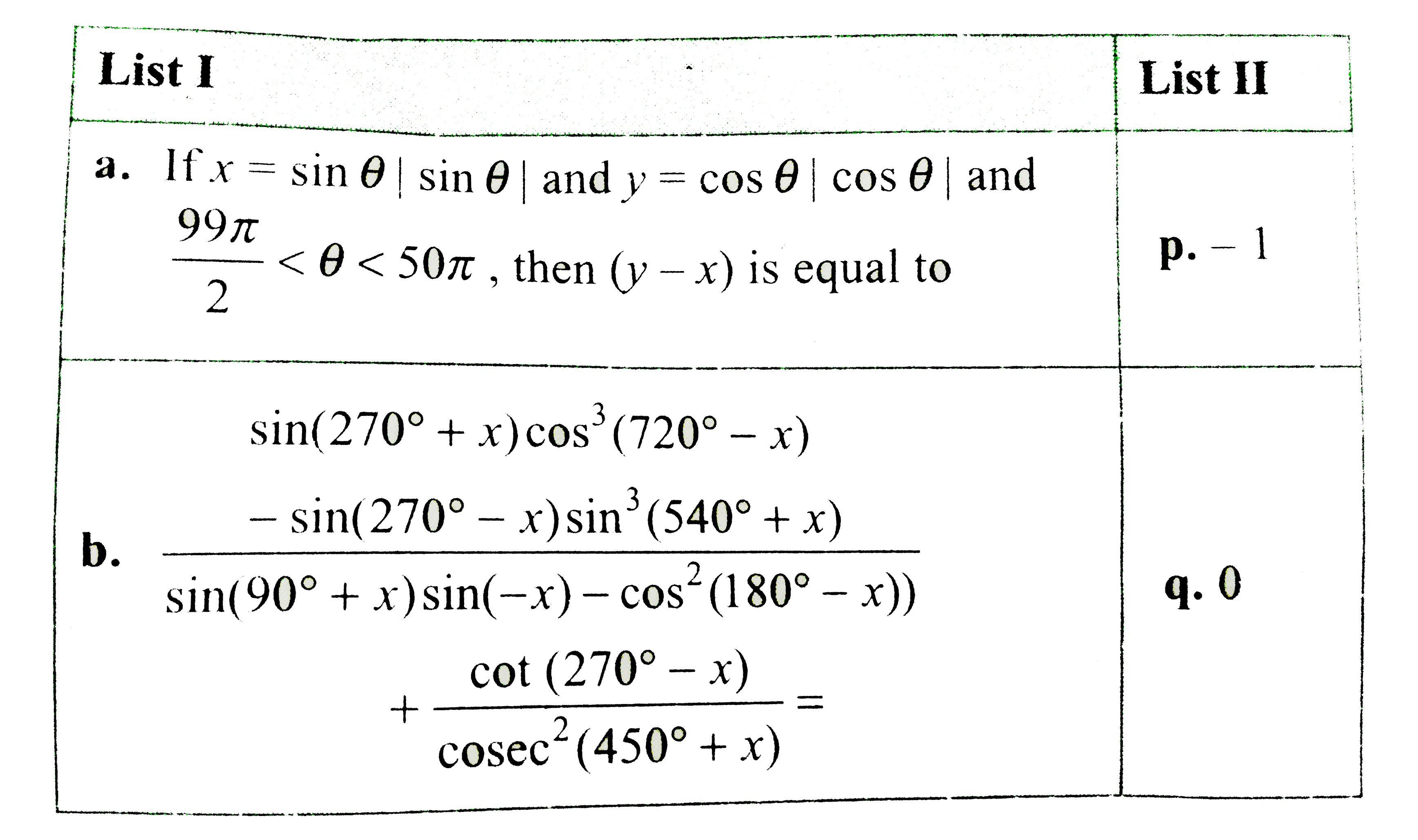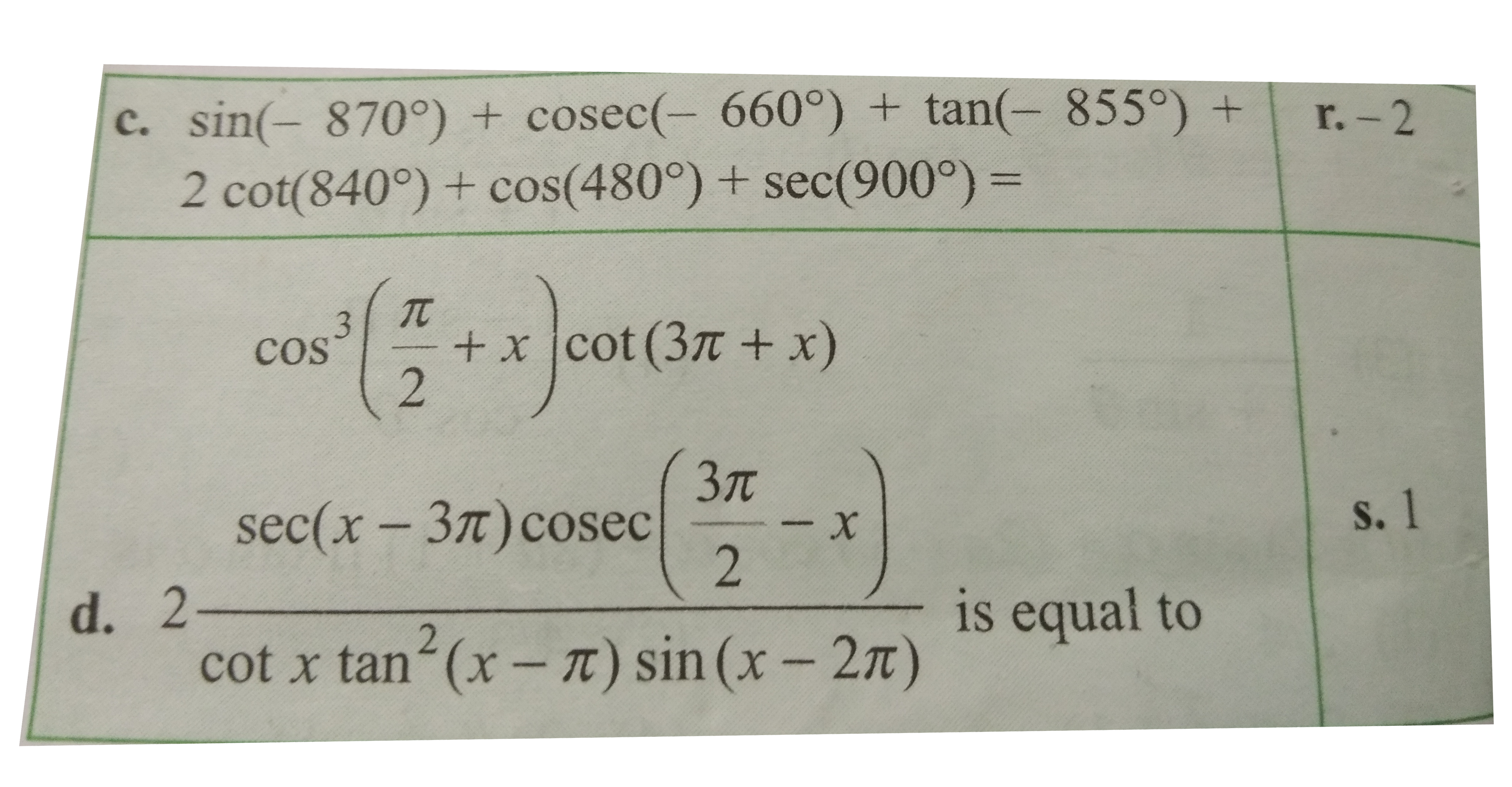Log f(x)=log((log)1/3((log)7(sinx+a))) be defined for every real value of x, then the possible value of a is 3 (b) 4 (c) 5 (d) 6Solution in Tamil
3
4
5
6
The correct Answer is:A, B, C
log1/3log6(sinx+a)>0
or0<log7(sinx=a)<1
or1<(sinx+a)<7,∀x∈R
or1−six<a<7−sinx
It is found that a should by less thanthe minimum value of (7 - sinx) and a must be greater the the maximum value of (1 - sinx). Thus,
⇒2<a<6
Topper's Solved these Questions
- BOOK - CENGAGECHAPTER - TRIGONOMETRIC FUNCTIONS EXERCISE - Exercise (Comprehension)11videos
TRIGONOMETRIC FUNCTIONS
- BOOK - CENGAGECHAPTER - TRIGONOMETRIC FUNCTIONS EXERCISE - Exercise (Matrix)3videos
TRIGONOMETRIC FUNCTIONS
- BOOK - CENGAGECHAPTER - TRIGONOMETRIC FUNCTIONS EXERCISE - Exercise (Single)57videos
TRIGONOMETRIC FUNCTIONS
- BOOK - CENGAGECHAPTER - TRIGONOMETRIC EQUATIONSEXERCISE - Archives (Matrix Match Type)1videos
TRIGONOMETRIC EQUATIONS
- BOOK - CENGAGECHAPTER - TRIGONOMETRIC RATIOS AND TRANSFORMATION FORMULASEXERCISE - Matrix Match Type1videos
TRIGONOMETRIC RATIOS AND TRANSFORMATION FORMULAS
Similar Questions
Let us consider the equation cos4xa+sin4xb=1a+b,x∈[0,π2],a,b>0
The value of sin2x in terms of a and b is03:11View Solution
 04:24View Solution
04:24View SolutionIf 5tanθ=4, then 5sinθ−3cosθ5sinθ+2cosθ is equal to 0 (b) 1 (c) 16 (d) 6
03:25View SolutionFind the derivative of y=tan−12x3
08:53View SolutionRefer to the following diagram :

Column IColumn IIa.Collinear vectorsp.→ab.Coinitial vectorsq.→bc.Equal vectorsr.→cd.Unlike vectors (same initial point)s.→d03:20View SolutionLeg f(x)=log((log)1/3((log)13((log)7(sinx+a))) be defined for every real value of x, then the possible value of a is 3 (b) 4 (c) 5 (d) 6
04:18View Solution. If log2,log(2x-1) and log(2x+3) are in A.P.then the value of x is (A) 5/2(C)log,5 (B) log25(D)logs3
03:24View SolutionThe maximum integral values of x in the domain of f(x)=log10(log1/3(log4(x−5)) is :
03:01View SolutionIf range of f(x)=(lnx)(lnx2)+lnx3+3ln2x+lnx2+2 can be expressed as [ab,cd] where a,b,c and d are prime numbers (not nacessarily distinct) then find the value of (a+b+c+d)2.
06:21View SolutionLet f(x)=log(log)13((log)7(sinx+a))) be defined for every real value of x, then the possible value of a is 3 (b) 4 (c) 5 (d) 6
02:32View SolutionLet f(x)=log1/3((log)13((log)7(sinx+a)) be defined for every real value of x, then the possible value(s) of a is (a) 3 (b) 4 (c) 5 (d) 6
03:00View SolutionThe number of integral values of a for which f(x)=log((log)13((log)7(sinx+a))) is defined for every real value of x is ________
03:11View SolutionLet f(x)=log(log1/3(log7(sinx+a))) be defined for every real value of x, then the possible value of a is
04:18View SolutionIf range of f(x)=(lnx)(lnx2)+lnx3+3ln2x+lnx2+2 can be expressed as [ab,cd] where a,b,c and d are prime numbers (not nacessarily distinct) then find the value of (a+b+c+d)2.
02:38View SolutionThe maximum integral values of x in the domain of f(x)=log10(log1/3(log4(x−5)) is : (a). 5 (b). 7 (c). 8 (d). 9
03:06View SolutionThe value of ∫e6logx−e5logxe4logx−e3logxdx is equal to
02:12View Solution

